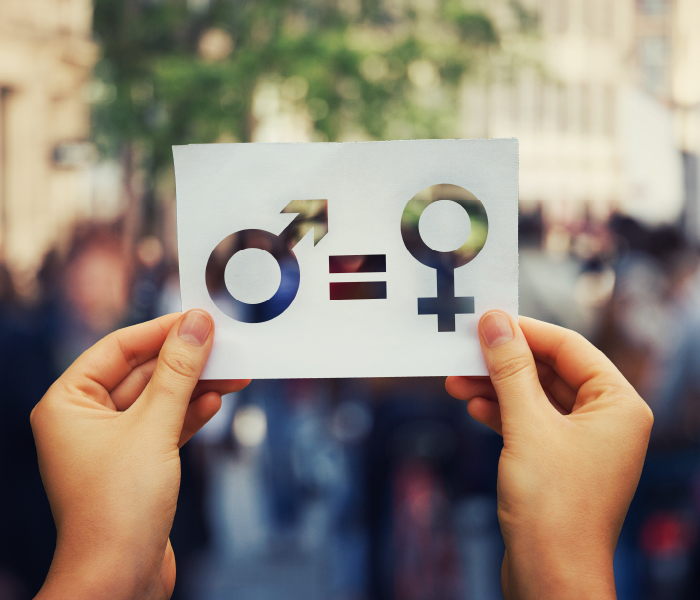Olympian and disability advocate Dean Barton-Smith shares his insights on inclusivity and accessibility that leaders can implement in their own workplaces.
Continue readingUntapped potential
When leaders of all genders, at all career stages, get serious about making workplaces work for women, then all of us win.
Continue readingParental leave. ‘It’s not a gender issue’.
IML ANZ chief executive David Pich, invites managers to rethink the way we evaluate the fairness of parental leave policies.
Continue readingHow to encourage employees to bring their whole selves to work
There’s a vital need to create working environments where everyone can feel they belong – in short, an inclusive workplace. To make that possible, you need to start at the top with managers and leaders.
Continue readingA legacy and a helping hand: The Eka Suputra IML Scholarship
Sometimes a simple helping hand can make a truly lasting impact on someone’s future. For Bianca Thatcher, a Bachelor of Business student at The Griffith Business School, a helping hand came in the form of the Eka Suputra IML Scholarship.
Continue readingLessons from Matariki: Why a strong sense of community is vital to good business
Matariki is about togetherness and forging a strong sense of community. It also teaches leaders vital lessons for good business.
Continue readingAttitude and actions: How to display leadership that supports equality
Less than a third of people working in science, technology and engineering in New Zealand are women. It’s no wonder that leading women in the industry, including manager of measurement, insight and reporting at the Energy Efficiency and Conservation Authority, Vij Kooyela MIML, are concerned.
 Kooyela believes that the challenge isn’t exclusive to leadership and management in the industry – there simply isn’t a solid pipeline of young women entering the workforce in this field.
Kooyela believes that the challenge isn’t exclusive to leadership and management in the industry – there simply isn’t a solid pipeline of young women entering the workforce in this field.
It’s not that the industry is lagging in taking positive steps toward social change. “The energy industry is in a fantastic space in New Zealand,” Kooyela admits. It is bolstered by policy directions that will benefit the environment, in particular the New Zealand Energy Strategy.
However, Kooyela can see that more can be done to grow the number of women in the energy sector.
Leaders’ actions matter
One factor that makes Kooyela acutely aware of the need for greater gender diversity in her industry is the team she manages. “My team are all men,” she says.
Kooyela would love to shake off the stereotype that male-dominated industries become that way due to natural abilities that men possess. “I don’t believe that girls are not as good as boys when it comes to quantitative skills. I think women have excellent communications skills and if that can be coupled with solid technical skills, then that’s an advantage.”
Simply put, the qualities of a good leader remain the same regardless of gender.
She also suggests practical ways for leaders to drive change:
- Language: For Kooyela, leaders should start with what they say. For example, when recruiting, she believes organisations should take a leaf off the UN, which include specific encouragement for women to apply for roles they advertise.
- Behaviour: Having once presented to an all-male room – and finding herself, the only woman, left alone on one side of the said room – Kooyela hopes more leaders will consider their actions. She challenges all leaders to remove all barriers to the equal treatment of people and to make everyone feel comfortable no matter the situation.
Leaders’ attitudes matter
Being no stranger to poor management experiences, Kooyela made a conscious decision to lead well. She found herself with a manager who didn’t do a great job and was described as a bully. Although for Kooyela, the focus was always on the silver lining. “I am so grateful for that experience because that is what pushed me to take the right steps, to demonstrate that [leadership] can be better and it can be done well,” Kooyela explains.
Since then, she has challenged herself to be a better manager and leader because of the impact she knows that leaders have on people. “If I can positively influence someone so that they make a step forward – whether that’s in their life or their career – that’s something very powerful,” Kooyela says.
However, she cautions other leaders, particularly women, to break away from the fear of uncertainty. “Leaders find comfort when we can tick all the boxes before venturing into something different and unknown. We want to get everything right,” she says.
Kooyela believes that more women should back themselves. For her, waiting for perfection is not the way forward.
Her advice? “Go for it. Don’t worry about having all the boxes ticked,” confirms Kooyela.
Leaders’ dialogue matters
“The key thing we are looking for is diversity of thought. Women do bring a different perspective on things and every workplace needs that balance of views,” says Kooyela.
What better way to gather a diverse set of views than through dialogue with a group of peers?
In March, for the first time, IML ANZ is hosting two International Women’s Day (IWD) events in Auckland and Wellington. This year, Vij Kooyela will join other leaders to explore the official IWD topic, ‘#EachforEqual’. Be part of the discussion and join forward-thinking managers and leaders in creating the type of dialogue that drives change.
Purchase tickets now:
Auckland – Friday, 6th March
Wellington – Friday, 13th March
Or for more information, contact events@managersandleaders.com.au.
#EachforEqual: How to create a gender equal workplace
By Gemma Lloyd
International Women’s Day is on 8 March 2020 and this year’s theme is #EachforEqual. It’s a good reminder that everyone has a role to play in helping create a gender equal world.
And a gender equal world means a gender equal workplace, where people are able to access and enjoy the same rewards, resources and opportunities regardless of gender.
While corporate Australia has been making progress on this front, it has a long way to go, with women still significantly underrepresented in leadership. According to the Australian Bureau of Statistics, only 13.7% of chair positions are held by women and only 17.1% of CEO positions.
Not only is a gender equal workplace what’s right and fair, it also makes good business sense. Working with some of Australia’s top employers, we see those companies with progressive gender equality policies consistently able to attract higher calibre talent – and retain them for longer. And the benefits of gender equality don’t stop there.
Gender equality health check
So how is your organisation tracking towards gender equality? Maybe it’s made progress in some areas but struggling in others, or there’s policies in place but room for improvement.
Conducting a gender audit is a good way to identify challenges and opportunities for increasing equality within your organisation, and create a plan for action.
WORK180 has gathered data from Australia’s most progressive companies, analysing their policies on flexible working, equal pay, parental support, career development and employee assistance. The result is a report and HR Health Check tool that employers can use to benchmark themselves against the best in their industry.
The HR Health Check only takes 10 minutes, and you’ll get a rating and high-level report comparing your business – you can get started here.
Future proofing your business
By being aware of HR benchmarks and trends, you’re in a better position to make informed policy decisions, and implement strategies that grow and future proof your business.
According to an EY global study, millennials will make up more than 75% of the workforce by 2025. And for them, a healthy work/life balance isn’t just a nice-to-have, it’s a deal-breaker.
In order to grow and future proof their businesses, and be able to attract and retain this massive segment of the workforce, organisations need to make changes to the way they engage with employees.
Smart companies are already doing just that. They’re changing and developing their policies and HR benefits, promoting positive outcomes for employees and employers, and offering greater support than the archaic and rigid workplace policies of the past.
8 ways to boost gender equality
Aside from conducting a gender audit and evolving policies, what are some practical ways that organisations can foster gender equality? In this WORK180 blog post, Dr Leonora Risse from RMIT University offered some useful tips:
- Make everyone automatically eligible for job promotions – instead of relying on candidates to self-nominate, which women are less likely to do, switch promotional opportunities from a choice to an automatic process.
- Don’t ask for volunteers, appoint them – don’t rely on community-minded women to voluntarily do the ‘office housework’. Instead, appoint these tasks systematically to ensure everyone in the office does their fair share.
- Remove gendered language from job ads – words that are stereotypically masculine or feminine in a job ad can have a powerful impact on whether a candidate applies or not. Use online gender bias decoder tools to screen job ads and make them more gender neutral.
- Calculate your organisation’s pay gap – companies need to first measure and recognise the existence of their gender pay gap, before they can fix it.
- Banish ‘manels’ – ensuring women are represented among panellists and speaker line-ups is critical for generating diversity of thought.
- Hand the microphone to a woman first – research shows that if a female asks the first question in a Q&A situation, it leads to more women asking questions than they would otherwise.
- Whose names and faces are on your walls? – if it’s mainly men, think about the message this sends about gender equality in your organisation.
- Explain why gender equality matters for men too – clearly communicate to your employees how gender equality and inclusive work practices deliver better outcomes for all.
Gemma Lloyd is the founder and CEO of WORK180, a recruitment platform that pre-screens employers to see how well they support women’s careers.
Join Gemma on 6th March at IML ANZ’s International Women’s Day Great Debate Event in Brisbane. Gemma will be joining five other leaders to debate whether ‘The world won’t listen unless women shout’.
How can your workplace help end period poverty?
This is a collaborative article written between women’s charity Share the Dignity and the Institute of Managers and Leaders. Share the Dignity are the official charity partner of IML ANZ’s International Women’s Day Great Debate on 6th March.
—
If you’re a woman reading this, you’ve probably been caught out in a public bathroom without a pad or tampon inside your handbag. You probably let out a swear word, a sigh and felt some frustration that you once again forgot to leave a tampon or pad in your bag like you promised yourself you would. You probably folded up a few tissues, placed them inside your underwear and ran to the closest store to purchase some sanitary items without a second thought.
Imagine that choice being clouded with the realisation that if you purchased a packet of pads or tampons, you wouldn’t be able to purchase dinner that night. Would you sacrifice skipping a couple of meals for a packet of tampons? Is that a decision you’ve ever had to justify? Every day, thousands of Australian women are deciding between eating a meal or taking control of their period.
Women’s charity, Share the Dignity, believe every woman has the right to her own dignity and should have access to pads and tampons regardless of her situation. Each year they host two sanitary item drives and an annual ‘It’s In The Bag’ campaign to collect much needed necessities for women across the country doing it tough. They rely heavily on the selfless work of volunteers to coordinate these donations to charities all over Australia. They also supply vending machines filled with free pads and tampons to low socioeconomic areas for those in need.
Without any government funding, Share the Dignity relies on the generosity of the public and corporations to help women in need.
If gender equity and female empowerment are important to you and your organisation, then supporting women who experience period poverty is a great way to make a difference. It doesn’t take much to help solve this issue and make an impact on the lives of thousands of women.
Here are several ways you can assist:
Become a collection point
As a collection point, the public and those within your workplace can donate pads and tampons to your collection box. A volunteer will collect the items and distribute them to local charities.
Make a monthly corporate donation
We all know periods are a monthly occurrence, making a monthly corporate donation ensures women are being assisted each month.
Volunteer your time
Volunteers are valuable assets for this women’s charity. Without them, thousands of women across the country won’t get the help they need. If you have five hours a week you can offer us, we would love your help in coordinating our supplies to those in need.
Support International Women’s Day
IML ANZ is proud to have Share the Dignity as our charity partner for our International Women’s Day Great Debate. On the day, Share the Dignity will be running a raffle to raise much needed funds for those experiencing period poverty.
Learn more about Share the Dignity’s work.
Host a workplace event
Get creative! Host a morning tea for $5 entry, organise a workplace raffle, run a bake sale, a silent auction or a dress up day.
Let your voice be heard
Powerful, passionate and thought-provoking, that’s IML ANZ’s International Women’s Day Great Debate event. This year IML ANZ is once again bringing together six hand-picked, opinionated and accomplished Australian leaders and personalities in an entertaining debate that challenges our ideas of equality, diversity and progress.
To join the Great Debate, book your tickets now!











